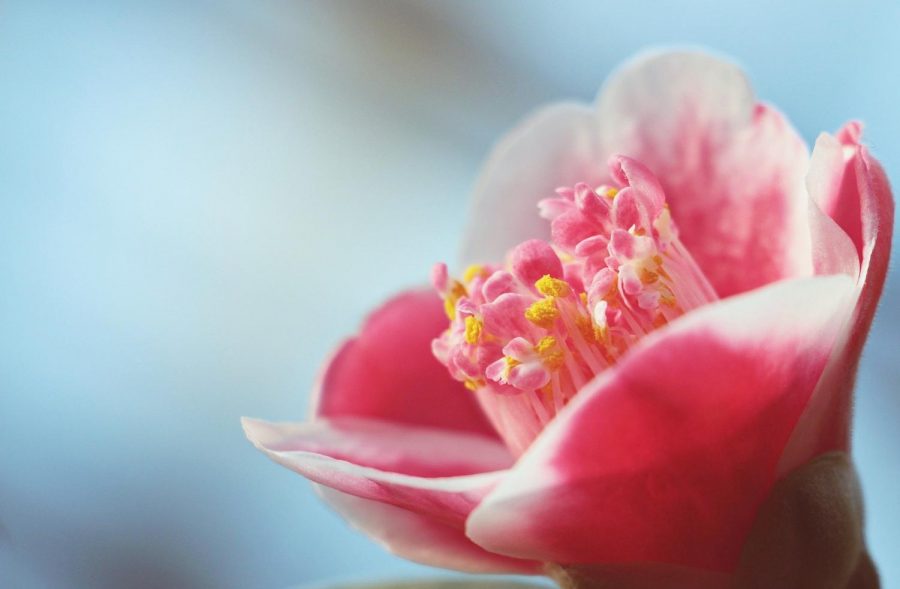Book Review: The Belles
The Price of Beauty
This is the Camellia flower which the main character, Camellia Beauregard is named after. Each Belle is named after a flower. Image courtesy of Pixabay.
January 6, 2021
In The Belles, written by Dhonielle Clayton, we are introduced to the world of Orleans where the Gris live. These people are said to have dull gray skin and bloodshot red eyes. They were cursed by the God of the sky, whereas the beautiful Belles were blessed by the Goddess of Beauty with special power called the arcana to spread beauty through Orleans. As the story unfolds, readers learn how far people will go to be beautiful. We follow the story through the eyes of the main character, Camellia Beauregard, one of the seven Belles whose life responsibility is to spread beauty to the people of Orleans.
In the modern world, beauty has controlled the lives of many, especially women. Beauty sometimes determines how other people treat you and can give you more opportunities depending on how aesthetically pleasing people find you. When I reference beauty, I mean beauty in societal standards. This book takes that concept and displays it through vivid characters such as Princess Sophia, another character in the book, to show how horrible beauty can make someone and on the opposite spectrum, we see how beauty can also hurt those who are said to control it. When asked about how she felt about how beauty standards can affect a girls self esteem, senior Tori Simmons says “beauty standards from Instagram or other social media platforms make it extremely easy for girls to compare themselves to others and it could really damage their mental health.” This concept can be seen through Princess Sophia who oftentimes would talk about how she wanted to be the most beautiful and through her dangerous actions, she would put others in harm’s way all for the sole purpose of achieving an impossible standard of beauty, even as the standard harmed her physically and mentally.
There are people throughout the kingdom who determine beauty standards and this is similar to our society in how an unsaid group of people creates trends that most people blindly follow. All of this effort is done just to have respect and to be seen as someone who deserves to have a place in this world because in some places appearances are everything. The Beauty Minister in the book is in charge of setting the trends that all of the people of Orleans want to follow. The people buy cosmetic products all said to help them meet up to the current beauty standards that are always changing. This parallels the real world, where the idea of who is beautiful and what makes them beautiful is always changing yet people are always willing to go with it because of how highly viewed beauty is. Of such standers, Senior Julia Groen says that “I think they’re bad, it just reinforces homogeneity… it’s just gonna cause people to chase the same standards that are honestly unattainable.” This idea aligns with the central message of the book which is that beauty standards can be harmful because of how impractical and unrealistic they are.
Though she is consistently told that she is beautiful the way she is, Princess Sophia cannot help but let her envy of others control how she interacts with the world.
When writing of her inspiration for the book, Clayton discussed her own problems with how she saw herself and, surprisingly, she based Sophia on how she used to see herself as a teenager. This reminds me of young teenage girls today such as the ones that go to ERHS. I have witnessed many girls feel so lowly of themselves because they do not think they meet up to the standard of beauty and as a result, it can drive them to be rude or envious of others. For some it can cause them to be depressed and desperate to become what they think is beautiful. When asked about how she thinks that beauty standards affect girls self esteem, senior Abigail Shirima says “I think beauty standards negatively affect teen girl’s self esteem because it makes it seem like we have to aspire to be ‘beautiful’ in order to be worth something.” Similarly to the book, in real life we can see that for girls beauty is heavily emphasized as something that we should want to maintain about ourselves in order to be worthy of respect from our peers. The book challenges this idea by showing how beauty is in the eye of the beholder and how beauty does not always and should not automatically guarantee respect.
Getting a Belle treatment to become beautiful is similar to that of plastic surgery. It causes excruciating pain to the individual experiencing the treatment, and even with that knowledge the Gris still undergo beauty treatments to maintain their appearance because appearance reflects status. The more money one has, the better the treatments they can get. However we find out that there are Belles being forced to work in horrid conditions and they themselves have disfigured faces or missing limbs, which in their world is deemed to not meet the standard of beauty. We learn that they are doing local beauty work for those who cannot afford it and are being forced against their will to make others beautiful. When it comes to beauty, everyone has to pay a price, literally and figuratively.
This book is a good read for those who are looking to read a book that is inclusive with characters of different skin tones, body shapes and sexualities. There even is LGBTQ+ representation and I believe that having representation in books is great because many different people at Roosevelt identify themselves with different backgrounds which are all important. This book is a great way to remind people to appreciate who they are more and understanding that every action has consequences and that the only perspective of yourself that should matter the most is your own.




